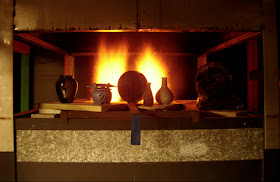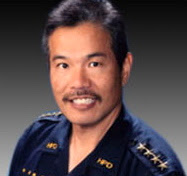 |
| High Fire Hawai`i artists participate in the annual Volcano Pottery Sale. See www.highfirehawaii.com. |
 |
| Police Chief Harry Kubojiri |
The chief and his staff are in the process of analyzing all of the individual comments collected so the Police Department can identify common concerns. The chief will then respond to the most common concerns expressed by the community members and visitors who participated in the survey. The responses to those comments and questions will be posted, along with the questions, on the Police Department’s website. In the meantime, the public may view the survey summary at hawaiipolice.com.
As in previous surveys, Chief Kubojiri said the survey and follow-up analysis are tools to assist him in identifying problem areas the community is experiencing with the Police Department, determining if he can rectify those issues through specific training of Police Department personnel, making changes to policies and procedures if necessary and clarifying misinformation about laws and/or police practices.
“Your feedback in past surveys has allowed us to make changes that were beneficial to the Police Department and the public we serve, and we will continue to publish surveys in the future,” Kubojiri said. “Your input is one of the many tools that we use in our continuing efforts to improve how we provide services to the public.”
In addition to processing comments from the survey, the Police Department will continue to hold monthly public meetings around the island to respond to concerns from the public. Kubojiri encourages community members to attend these public meetings or communicate their concerns or comments using the Feedback link on the Police Department’s website, hawaiipolice.com.
THE FIFTH ANNUAL VOLCANO POTTERY SALE continues today until 3 p.m. at Volcano Art Center’s Ni`aulani Campus in Volcano Village, featuring newly created work by twelve ceramic artists of East Hawai`i. Samples of Volcano-grown teas are available courtesy of Tea Hawai`i, with sushi and bentos for purchase from Volcano Hanabi. For more information, see ryhpottery.com/volcano_pottery_sale or call 985-8530.
THE PUBLIC IS INVITED TO HAVE LUNCH WITH A RANGER tomorrow from 10:30 a.m. to 12:30 p.m. at Hawai`i Volcanoes National Park’s Kahuku Unit. Participants bring a bag lunch and join Park Ranger Kiko on Father’s Day in an open discussion on park resources including significant geological events and features of Mauna Loa and the natural and cultural history of the Kahuku Unit.
TEA FOR FATHERS & DAUGHTERS/MOTHERS & SONS takes place Tuesday at 2 p.m. at Volcano Art Center’s Ni`aulani Campus in Volcano Village. The menu at this special tea to celebrate children, mothers and fathers and grandparents includes finger sandwiches, salad, scones, desserts and a special tea favor all for $15 per person. Reservations are required by Monday. Contact JoAnn Aguirre at teaquiero@yahoo.com or 982-7691.
SUPPORT OUR SPONSORS AT PAHALAPLANTATIONCOTTAGES.COM AND KAUCOFFEEMILL.COM. KA`U COFFEE MILL IS OPEN SEVEN DAYS A WEEK.
ALSO SEE KAUCALENDAR.COM AND FACEBOOK.COM/KAUCALENDAR.
“Your feedback in past surveys has allowed us to make changes that were beneficial to the Police Department and the public we serve, and we will continue to publish surveys in the future,” Kubojiri said. “Your input is one of the many tools that we use in our continuing efforts to improve how we provide services to the public.”
In addition to processing comments from the survey, the Police Department will continue to hold monthly public meetings around the island to respond to concerns from the public. Kubojiri encourages community members to attend these public meetings or communicate their concerns or comments using the Feedback link on the Police Department’s website, hawaiipolice.com.
 |
| Dr. Fred Mackenzie |
NEW RESEARCH SUGGESTS THAT HUMAN ACTIVITY could be increasing the movement of carbon from land to rivers, estuaries and the coastal zone, indicating that large quantities of anthropogenic carbon may be hidden in regions not previously considered, according to a study recently published in Nature Geoscience.When carbon is emitted by human activities into the atmosphere, it is generally thought that about half remains in the atmosphere and the remainder is stored in the oceans and on land.
The study by Dr. Fred Mackenzie, emeritus professor of Oceanography at the University of Hawai`i at Manoa School of Ocean and Earth Science and Technology, and colleagues from the Université Libre de Bruxelles, the University of Exeter, Laboratoire des Sciences du Climat et l’Environnement and ETH Zurich showed, for the first time, that increased leaching of carbon from soil, mainly due to deforestation, sewage inputs and increased weathering, has resulted in less carbon being stored on land and more stored in rivers, streams, lakes, reservoirs, estuaries and coastal zones – environments that are together known as the land-ocean aquatic continuum.
The study reviewed previously published data and showed that a significant amount of the carbon emitted through human activity that is taken up by the land is not actually stored there, but in the aquatic continuum.
Pierre Regnier, from Université Libre de Bruxelles, said, “The budget of anthropogenic CO2 reported by the Intergovernmental Panel on Climate Change currently does not take into account the carbon leaking from terrestrial ecosystems to rivers, estuaries and coastal regions. As a result of this leakage, the actual storage by terrestrial ecosystems is about 40 percent lower than the current estimates by the IPCC.”
The study reviewed previously published data and showed that a significant amount of the carbon emitted through human activity that is taken up by the land is not actually stored there, but in the aquatic continuum.
Pierre Regnier, from Université Libre de Bruxelles, said, “The budget of anthropogenic CO2 reported by the Intergovernmental Panel on Climate Change currently does not take into account the carbon leaking from terrestrial ecosystems to rivers, estuaries and coastal regions. As a result of this leakage, the actual storage by terrestrial ecosystems is about 40 percent lower than the current estimates by the IPCC.”
 |
| Pierre Regnier |
The land-ocean aquatic continuum has not previously been considered an important carbon sink. Future assessments of carbon storage must now take into account the surface areas of the land-ocean aquatic continuum to ensure accurate estimation of carbon storage. This will also require an improved knowledge of the mechanisms controlling the degradation, preservation and emissions of carbon along the aquatic continuum to fully understand the impact of human activity on carbon transfer.
Professor Pierre Friedlingstein, from the University of Exeter, said, “Carbon storage in sediments in these rivers and coastal regions could present a more secure environment than carbon stored in soil on land. As soil warms up, stored carbon can be lost to the atmosphere. The chances of this occurring in wet sediments are reduced.”
A fraction of the carbon that leaches from land to the land-ocean aquatic continuum is emitted back to the atmosphere, while another fraction is sequestered in sediments along the continuum. Only a minor part, about 10 percent, eventually reaches the open ocean.
Philippe Ciais, from the Laboratoire des Sciences du Climat et l’Environnement, said, “Our revisited global carbon budget, which includes the land-ocean aquatic continuum, is still entailed with significant uncertainties. It is, however, fully consistent with the observed growth rate of atmospheric CO2. Our downward revision of the land carbon storage is also in agreement with very recent results from forest inventories.”
A significant part of the carbon storage thought to be offered by ecosystems on land – mainly forests – is thus negated by this leakage of carbon from soils to aquatic systems, and to the atmosphere, according to the study.
For more information, see the article at dx.doi.org/10.1038/NGEO1830.
A fraction of the carbon that leaches from land to the land-ocean aquatic continuum is emitted back to the atmosphere, while another fraction is sequestered in sediments along the continuum. Only a minor part, about 10 percent, eventually reaches the open ocean.
Philippe Ciais, from the Laboratoire des Sciences du Climat et l’Environnement, said, “Our revisited global carbon budget, which includes the land-ocean aquatic continuum, is still entailed with significant uncertainties. It is, however, fully consistent with the observed growth rate of atmospheric CO2. Our downward revision of the land carbon storage is also in agreement with very recent results from forest inventories.”
A significant part of the carbon storage thought to be offered by ecosystems on land – mainly forests – is thus negated by this leakage of carbon from soils to aquatic systems, and to the atmosphere, according to the study.
For more information, see the article at dx.doi.org/10.1038/NGEO1830.
 |
| Richard Onishi |
KA`U’S STATE REP. RICHARD ONISHI HOSTS a community meeting today at 2 p.m. at Aupuni Center Conference Room
101 to brief the community on the 2013 legislative session and hear feedback on issues that matter to constituents. Other lawmakers joining Onishi are vice speaker John Mizuno, majority leader Scott Saiki, majority floor leader Karen Awana and state representatives Mark Nakashima, Clift Tsuji and Faye Hanohano.
THE FIFTH ANNUAL VOLCANO POTTERY SALE continues today until 3 p.m. at Volcano Art Center’s Ni`aulani Campus in Volcano Village, featuring newly created work by twelve ceramic artists of East Hawai`i. Samples of Volcano-grown teas are available courtesy of Tea Hawai`i, with sushi and bentos for purchase from Volcano Hanabi. For more information, see ryhpottery.com/volcano_pottery_sale or call 985-8530.
THE PUBLIC IS INVITED TO HAVE LUNCH WITH A RANGER tomorrow from 10:30 a.m. to 12:30 p.m. at Hawai`i Volcanoes National Park’s Kahuku Unit. Participants bring a bag lunch and join Park Ranger Kiko on Father’s Day in an open discussion on park resources including significant geological events and features of Mauna Loa and the natural and cultural history of the Kahuku Unit.
 |
| JoAnn Aguirre hosts a special tea Tuesday. Photo from Hawai`i Tea Society |
KA `OHANA O HONU`APO’S FATHER’S DAY EVENT tomorrow from 1 p.m. to 4 p.m., includes musicians on stage, sales of food, beverages and shave ice, and a shady tent to enjoy Honu`apo Park on Father’s Day. The Pork in the Park barbecue contest has been postponed due to lack of participation. For more information, call Lehua Lopez-Mau at 929-9891.
TEA FOR FATHERS & DAUGHTERS/MOTHERS & SONS takes place Tuesday at 2 p.m. at Volcano Art Center’s Ni`aulani Campus in Volcano Village. The menu at this special tea to celebrate children, mothers and fathers and grandparents includes finger sandwiches, salad, scones, desserts and a special tea favor all for $15 per person. Reservations are required by Monday. Contact JoAnn Aguirre at teaquiero@yahoo.com or 982-7691.
SUPPORT OUR SPONSORS AT PAHALAPLANTATIONCOTTAGES.COM AND KAUCOFFEEMILL.COM. KA`U COFFEE MILL IS OPEN SEVEN DAYS A WEEK.
ALSO SEE KAUCALENDAR.COM AND FACEBOOK.COM/KAUCALENDAR.